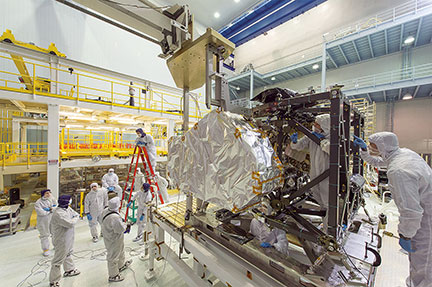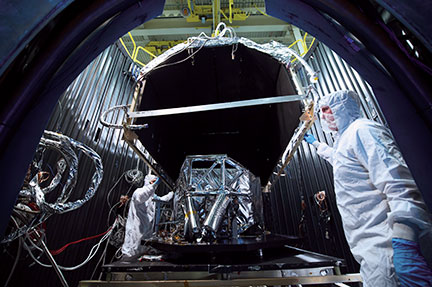
[SatNews] The Near Infrared Spectrograph (NIRSpec), developed and built by Airbus Defence and Space, and the Mid-Infrared Instrument (MIRI), built by a European consortium led by the company, have successfully passed a 120-day cryogenic vacuum test campaign within the Integrated Science Instrument Module (ISIM) of the James Webb Space Telescope (JWST).

In March 2014, the James Webb Space Telescope's flight Near Infrared Spectrograph (NIRSpec) was installed into the instrument module. NIRSpec joins the flight Near Infrared Camera (NIRCam) Fine Guidance Sensor/ Near Infrared Imager and Slitless Spectrograph (FGS/NIRISS) and Mid-Infrared Instrument (MIRI) which are already integrated into the ISIM, making the instrument module complete.
Photo credit: NASA/Chris Gunn.
This test was the second of three at NASA’s Goddard Space Flight Center in Washington D.C. and the first with all flight science instruments installed in ISIM. The NIRSpec and MIRI instruments have been provided under a European Space Agency (ESA) contract. After launch in 2018 on an Ariane 5 from Europe’s spaceport in Kourou, French Guiana, the JWST will detect and analyse the very faint light from the first stars and galaxies that formed in the Universe. During the test campaign, supported by Airbus Defence and Space, the thermal vacuum chamber at NASA cooled the ISIM and its instruments to their operating temperatures, around 38K (-235°C) for NIRSpec and 6.7K (-266°C) for MIRI. It took about three weeks for the instruments to reach these temperatures. Then the instruments underwent dedicated functional and performance tests and extensive check-outs.
Following the completion of this test campaign, the ISIM will be put in its flight configuration and will then be subjected to acoustic, vibration and electromagnetic compatibility testing to simulate the launch environment. The third and final ISIM thermal vacuum test will be performed in 2015, verifying that ISIM and all science instruments are working as specified before delivering ISIM to the next level of the telescope integration and testing.
NIRSpec will be capable of measuring the spectrum of up to one hundred objects simultaneously. That will enable NIRSpec to observe large samples of galaxies and stars at unprecedented depths across large swathes of the Universe and far back in time. MIRI, a combined camera and spectrograph for mid-infrared wavelengths, will extend JWST’s observation capabilities to longer wavelengths than covered by its other instruments, vital for the study of light from objects in the early universe or to peer inside dust clouds where stars and planetary systems are forming today.
“Our instruments represent the pinnacle of technology for modern astronomy,” said Head of Space Systems François Auque. “JWST will be hugely important in expanding our understanding of how our universe evolved. Especially NIRSpec is further proof of Airbus Defence and Space’s unrivaled expertise. We are proud to be supporting the scientific research that JWST will carry out.”

NASA testing the Webb Telescope's MIRI thermal shield.
Image Credit: NASA/Chris Gunn.
NASA, ESA, and the Canadian Space Agency (CSA) are collaborating to develop JWST, which will replace the legendary Hubble telescope and enable observation and measurement of infrared wavelengths. JWST will be able to study key phases in the evolution of the Universe in great detail—from the first stars and galaxies to form after the Big Bang to the formation of planetary systems in our own Milky Way galaxy today. This will be made possible by JWST’s suite of four highly-sensitive scientific instruments and its huge primary mirror made of 18 hexagonal segments spanning a total of six and a half meters in diameter. JWST will be the largest astronomical telescope in space
For more information, please visit the Airbus Defence and Space infosite at http://airbusdefenceandspace.com/

